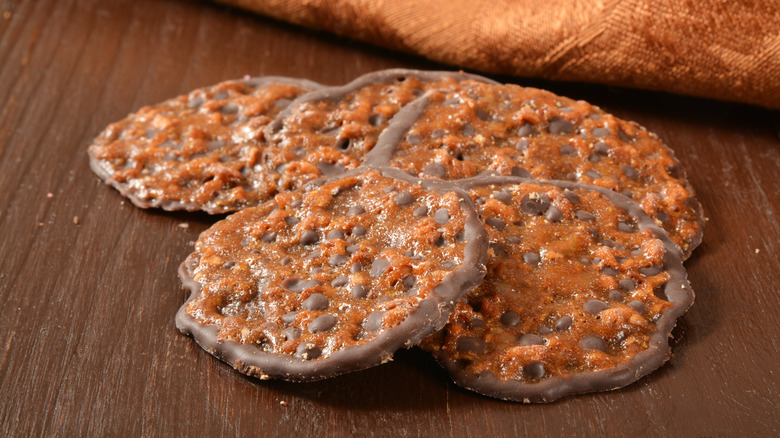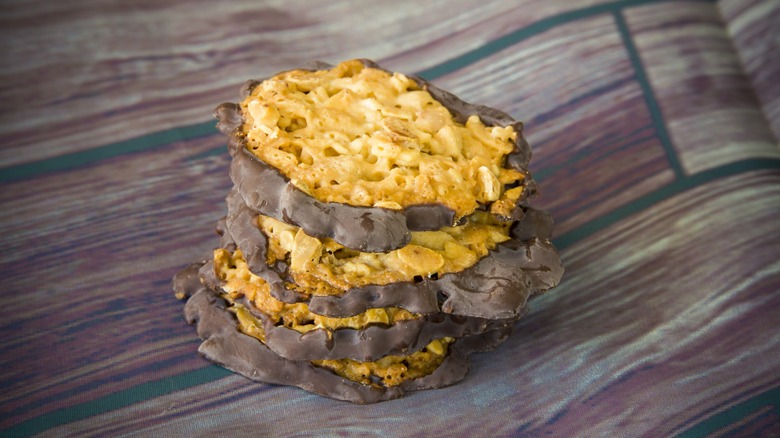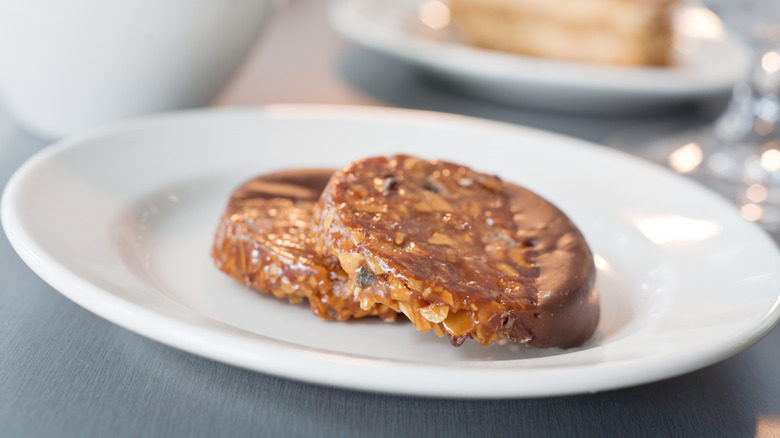The Light And Crispy French Cookies Inspired By Gold Coins
Everyone has their favorite cookie. Maybe it was the one their grandmother made every year when they visited for the holidays. Or the kind their parents taught them to make from scratch by looking over their shoulder and giving them directions. Whatever the case may be, and whether your favorite cookie might be old-fashioned butter cookies, red velvet cookies, or molasses ginger snap cookies, you've got one — and for the children of Europe, their favorite might very well be the Florentine.
Florentine cookies are not made from your ordinary batter of eggs, sugar, and flour. Instead of being light, fluffy, and cakey, Florentines are thin and crispy and often served as a quintessential snack alongside your order of coffee in Europe (via Culinary Ginger). These sweets with their toffee texture and nutty sweet flavor are absolutely the perfect bake to make for your family or friends to snack on during the holidays, but just because they are named "Florentine" cookies, doesn't mean that these guys are Italian in nature.
The origin of the Florentine cookie
Though you might logically suspect that the Florentine might have originated in a bakery located in Florence, Italy, that is not the case, though Italy may have inspired the cookie in some way. According to Dalo Florentines, the Florentine cookie recipe first appeared in print during the mid-17th century, though it did not resemble the lacy cookies we enjoy today. When we order a Florentine cookie in the 21st century, we expect a brittle cookie decorated with chocolate. It is believed that the Florentines we recognize now were invented in France.
So, where did the Florentine name come from? Dalo Florentines believes that they might have been named after Florence's gold coins, which were used as currency throughout Europe for nearly 500 years. Taste Atlas claims that though the exact story of the cookie's creation is lost to history, they have lived on in European homes as a favorite holiday treat made with nuts, sugar, honey, candied fruit, and butter — plus everyone's favorite sweet, chocolate! These treats are famously good for dunking into various warm holiday drinks or making Florentine cookie sandwiches with eggnog icing.
How are Florentine cookies made?
Florentine cookies can be made using a variety of ingredients, but regardless of what you use to whip them up, these goodies must be thin, crispy, buttery, and have notes of caramel or toffee, or else are they really Florentine cookies at all? Better Homes & Gardens says that the Florentine is made by making a nut base of almonds or hazelnuts, plus candied fruit of your choice (though popular options are cherries and oranges), melted butter, and heavy cream. These ingredients become a kind of candy that is then to be drizzled or coated (depending on your preference) with chocolate!
Masterclass warns that these cookies will spread out in the oven, so make sure they are placed far apart from each other. A few ways to ensure your homemade Florentine cookies turn out tasting divine: Masterclass recommends using blanched almonds for this dish so that the lace of the dessert turns out extra fine and delicate. And something you absolutely must do is remember to add chocolate after baking. Bittersweet chocolate should be melted and artfully dripped atop the Florentine or spread along the flat bottom. The chocolate flavor pairs perfectly with the fruit and nuts used to make the base!


